July 1989: A stranger with a colander full of fragrant mushrooms changed my life. Reinhardt, a German scientist with wild hair, in khaki shorts, rushed into our dooryard, displayed his heap of gold chanterelles, and begged for a basket to continue the hunt.
“In your country, no one sees what treasure is here right beside us,” his rant began. Reinhardt was staying the night with our closest neighbors – a doctor and his partner, not wild food enthusiasts – who pictured a skull and crossbones over their last meal. To avert disaster, they knew where to bring their fervent guest.
Welcome to Total Loss Farm, our old commune in Guilford, Vermont. It was a typical evening: dinner in the making, field-grown vegetables, home-raised pork chops, strawberry-rhubarb pie. Nothing wrong with our provisions.
We gazed at the glowing fungus and set down our knives. On the farm, we baked bread and fermented not-bad wine. Years ago, I’d injected Roquefort mold into homemade cheese. When the airborne mold flavored all our dairy products, I scrubbed the kitchen and abandoned the experiment. But here was the missing mystery ingredient in our summer. I turned off the oven. We picked up baskets and followed Reinhardt up the steep pasture, through the pucker-brush, across the stone wall, into the conifers. This was our gateway into the fifth kingdom of fungus.
Flashback, 1951: Our first mushroom was the radioactive cloud on TV from the bomb detonated to prevent nuclear war. Civil defense drills had our generation hiding under desks in suburbs that had sprung up overnight like mushrooms after rain. Where I lived, the earth was carved into house lots: private property. Nature was a nuisance or a force to be manicured and curbed. If mushrooms invaded my father’s lawn, there was a spray.
Reinhardt vanished soon after sautéing a splendid dish of chanterelles. He promised we would find more. “Or perhaps,” he said, “the mushrooms will find you.”
Early each morning, we wandered away from rows of corn and beans into dappled light and shadow. We took familiar logging roads, armed with penknives, baskets, mesh bags, and The Audubon Society Field Guide to North American Mushrooms. The introduction had alluded to old myths: mushrooms rising from Zeus’s lightning striking the earth, little people dancing in fairy rings, the hallucinogenic food of the gods. Songbirds trilled in the canopy. I walked through spider webs laced with dew. I narrowed my gaze to the base of trees, to fallen trunks or standing ones with damaged bark. With each foray, I learned to watch my step while sweeping the distance with my eyes. We wandered together without speaking or branched out on our own. We gathered pale white oysters and angel wings, king boletes, chicken of the woods. In separate baskets, we brought home fungi to identify with spore prints – laying out the caps on paper or glass, waiting overnight, matching their colors to those in the field guide. We cooked only safe mushrooms cross-referenced and endorsed by experts. Of all we served, only the boletes were slimy and disheartening, but breaded, they made delightful fritters.
That first summer, Mimi and I brought our daughters, then eight and nine, on our crazy hunts. Down by the Green River, my daughter pointed out an iridescent mushroom that we identified as the choice pig’s ear (Gomphus clavatus)! Another time, the girls, fortified by wild raspberries, ran ahead and found a hundred mushrooms jutting from a steep bank. They called it “Chanterelle City.”
The kids soon lost interest, but we were devotees. Our brilliant communal forays – to the black trumpets, hen of the woods, lion’s mane, shaggy parasols, aborted entolomas – defined each season toward the end of the twentieth century. The more we ate, the more we found. The more we learned, the more we longed for. Attuned to the hunt, we felt a kinship with the subterranean forest.
Although mushrooms seem to appear at random, they are part of a network of threadlike hyphae growing underground and reaching below bark. These microscopic hyphae, woven together, form the mycelium, branching filaments that share nutrients with their neighbors and decompose matter. Fungi and plants have evolved symbiotic relationships called mycorrhizae, which allow them to feed each other and communicate even across a distance. The mushroom we prize is the fruiting body resulting from this complex life form. Left alone, its spores spread the code.
Is there a stream of consciousness flowing through the fungi, flora, and fauna to us? Decades after the psychedelic reveries of the 1970s but before the era of the World Wide Web, I wondered, “is this stream real or just a metaphor?”
In the twenty-first century, to find an answer, I leave the wilderness, boot up, and Google “mushroom.” Reputable sources rhapsodize online. BBC Earth reports, “Plants talk to each other using an Internet of fungus.” In the community of the forest, conversation tends to center on nurture. I scroll down to the name Paul Stamets. In seconds, the visionary mycologist emerges, speaking of the connection between dark matter and mycorrhizae. Creative thinkers draw on the untapped healing power of nature to build the information highway we travel together.
With three and a half million viewers, I watch Paul Stamets’s TED talk, “6 Ways Mushrooms Can Save the World.” For each plague – from carpenter ants, flu viruses, and cancer to farm pollution, toxic spills, and nuclear disaster – Stamets summons remedies from majestic, resilient mycelium.
With a million viewers, I watch inventor Eben Bayer’s TED talk, “Are Mushrooms the New Plastic?” Bayer manufactures packaging material from agricultural waste and fungi. A replacement for Styrofoam, the product protects fragile things – including the environment.
With 140,000 viewers, I watch artist Jae Rhim Lee’s TED talk, “My Mushroom Burial Suit.” Lee designed “ninja pajamas” infused with “infinity mushrooms,” fungi that are bred to compost the body, toxins and all, healing the earth with each death.
Alone, I stream writer Michael Pollan’s radio talk, “The Trip Cure,” about the use of psilocybin mushrooms by cancer patients. Through a single, guided cosmic experience, participants transform their mortal fear into connection, serenity, and joy.
What is this intimacy we share with mushrooms? I find Ari Rockland-Miller, 30, seasoned mycophile, guide, and writer, through his website, The Mushroom Forager. At their home in Brattleboro, his wife Jenna Antonino DiMare appears with a bowl of morels, pocked and fragrant, from the weekend’s foray. Rockland-Miller begins with the growing certainty of where, how, and when to hunt.
There’s the morel rain, maitake rain, and the chanterelle rain: the rain that summons the season. You develop the intuition and then the anticipation. To follow the passage of the mushrooms, I read the landscape. Pattern language is also part of it: for morels, an ash tree, a transition, plus the month of May. Patterns involve ecology and timing, and the nuances of a specific place.
I crave that sensation. Mushrooming is different from birding. It is a similar pursuit of a wild, enigmatic organism. But with mushrooming you often end up eating it, so there’s literally, the merger of mushrooms and your body. There’s that intimacy. You’re solely in the moment, almost becoming wild yourself.
Even with species I forage year after year, there’s a calling. Is it the mycelium calling something inside of me? Why do they taste so good? Why do they entice us and draw us in? Maybe they want to be consumed, maybe they want us to spread their spores. Who knows? A deep-down, primal part of me enjoys foraging. Maybe it’s an evolutionary-interconnection, but there is something very rewarding about getting back in touch with that hunter-gatherer mindset.
In 1989, I highlighted “fruiting body” in the Audubon field guide because the metaphor confirmed my theory: there is always more to life than meets the eye. Invisible alliances and communal labor nurture each choice mushroom and invention. I’ve foraged language far longer than fungi. I walk the forest deep in conversation. Still the fruiting body of a poem emerges as a little miracle – “chanterelle: trill of the thrush made edible.”


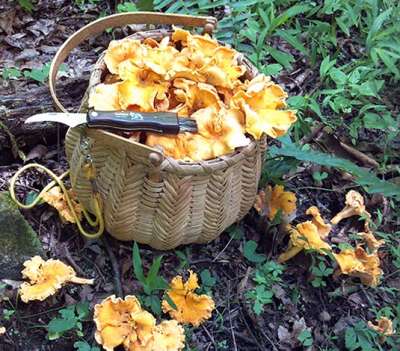


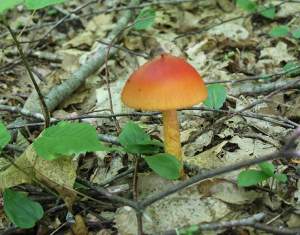
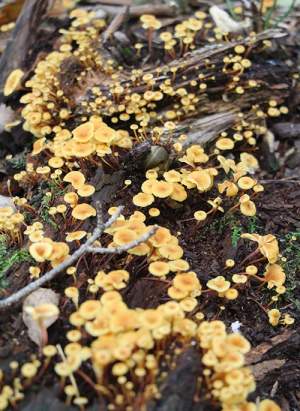
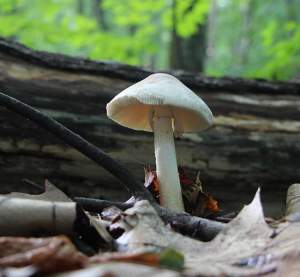
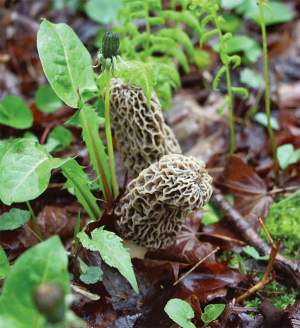
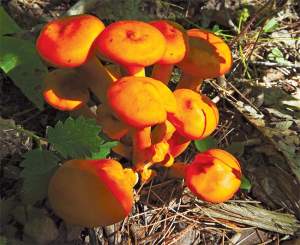
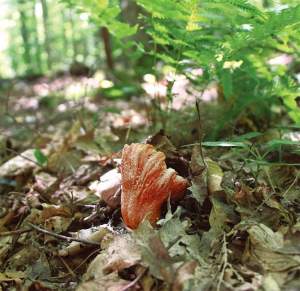
Discussion *